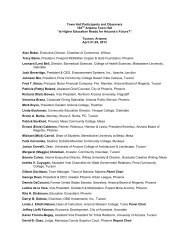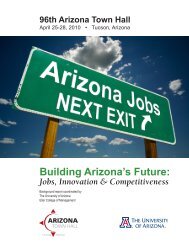Background Report - Arizona Town Hall
Background Report - Arizona Town Hall
Background Report - Arizona Town Hall
You also want an ePaper? Increase the reach of your titles
YUMPU automatically turns print PDFs into web optimized ePapers that Google loves.
56,000 visitors a year, nearly 75% of those from outside Wickenburg. That represents a<br />
significant contribution to economic development in a community that has very little industry.<br />
While prominent, the cultural institutions in Wickenburg face a challenge in building<br />
bridges with business owners and residents in the community. Cultural institutions struggle to<br />
meet the needs and appeal to the interests of full-time residents as well as part-year residents<br />
and visitors. Figuring out how to serve all of those constituencies is a daily challenge.<br />
In this tough post-Great Recession economy, cultural organizations seek more than ever<br />
to create relevant connections with their communities. Some are doing so with half of the<br />
pre-recession human and financial resources, largely through the spirit of volunteerism that<br />
is particularly strong in rural communities.<br />
Telling Stories<br />
Carrie Gustavson, Director, Bisbee Mining & Historical Museum<br />
<strong>Arizona</strong> possesses a remarkable landscape, which framed by the borders of our geographically<br />
large state, has created its distinctive sense of place. But it is not defined by a single<br />
community, be it a Phoenix or a Bisbee, but rather by the startling diversity of its places<br />
and people, each of which has a distinctive story to tell. These chronicles represent a<br />
multitude of voices and narratives which are celebrated by the many cultural organizations<br />
located in rural <strong>Arizona</strong>.<br />
The rural <strong>Arizona</strong> of a place like Bisbee, distant from the state’s major urban centers,<br />
derives its identity neither from the many legislative decisions made by government officials<br />
in metropolitan Phoenix nor from the headlines randomly picked up by state or national<br />
media. The experience of rural <strong>Arizona</strong> is more immediate, an intrinsic part of our lives. We<br />
are all—past, present, and future—part of the story.<br />
The Bisbee Mining & Historical Museum is a community history museum, and like<br />
other rural institutions throughout the state, plays a significant role in interpreting how<br />
<strong>Arizona</strong>ns understand their shared heritage, assess the present, and plan for the future.<br />
As common tradition fades, <strong>Arizona</strong>’s hundreds of smaller rural museums assume the<br />
stewardship of teaching communities the importance of not only preserving history, but of<br />
understanding the nature of the history we seek to preserve, and the lessons it offers for today.<br />
Community museums are, in essence, in the front line of the history business, and collectively<br />
such histories of which they are guardians are the foundation of our image as a state. But<br />
community museums could improve their impact by looking beyond their local communities<br />
to weave their local and regional stories into an understanding of the collective experience of<br />
<strong>Arizona</strong> as a whole.<br />
The story of Bisbee’s mines is anything but a local one. <strong>Arizona</strong> is known as the copper state,<br />
and mining was the transformative industry of the American West, with Bisbee as an important<br />
arena in which social and economic issues of statewide and national importance were played<br />
out. Some of the richest copper mines in the world were located here, and it was once the<br />
Chapter 16 | 167




